By David Seaman | Echo
You may have noticed something different while walking through the Metcalf Visual Arts Center recently.
Golden frames glint and the distinctive smell of old paintings capture your senses. Buffalos basking in the warm light of the moon watch as you wander by. A Native American woman runs with the wolves, and banditos fall into rivers as you hurry through the building to your next class. But these works capture your attention, make you pause.
You stop and stare and wonder. A cowboy riding a bucking horse and American Indians struggling through a terrible trail intrigue your imagination. In the distance, you swear you hear war cries. Maybe even the whistle of a rancher.
What you are experiencing is "The Spirit of the American West," an exhibit featuring Western art from the private collection of Taylor friends Leland and LaRita Boren. The show began on Aug. 22 and will continue until Oct. 5, with an opening reception planned for Sept. 11. There is no charge for admission.
Taylor's display contains 60 pieces and marks the first time select works from the 405-piece Boren collection have been widely accessible. Breathtaking works in oil, watercolor, pastel, bronze and more make up the collection, which highlights the dangerous and adventurous times of the American West. Alongside fascinating paintings and sculptures, a lecture series will coincide with the display.
"We wanted it to be an academic program, not just come and look at the art," said Kathy Herrmann, co-chair of the Art Department and assistant professor of art.
The idea for the exhibit and lectures came about in the spring. The department wrote a proposal to the Clowes Foundation, which makes contributions to organizations that promote the fine arts.
"As an educational experience, an opportunity for the public to view this significant collection outside of (Boren's) private office area, we were awarded the grant and that's what got it all started," said Suzie Dittenber, assistant professor of art.
The grant is significant, allowing the university to bring in well-known speakers. "A big part of the proposal was how this was going to benefit the community, not just in Taylor, but in the extended community," Herrmann said. "It is a very different genre of work than what we typically have here."
Among the lecturers is Edgar Heap of Birds, the keynote speaker. A Native American artist and professor of Native American studies at the University of Oklahoma, Heap of Birds has lectured all over the world about issues related to indigenous peoples.
"My lecture will cover contemporary Native American public art and studio art practice as well as Native history and ceremonial understanding," Heap of Birds said in an email. He will also teach a tipi-making workshop on Sept. 25, the same date as the lecture.
History Department Chair Tom Jones will lead a lecture on helping elementary through high school students connect to the American West on Sept. 16. Phil Loy, professor emeritus of political science, will focus on the western frontier as seen in movies and television.
"My presentation will focus on the idea (that) the western frontier was the source of American myths and legends that have helped to shape our national identity," Loy said. Referencing specific pieces in the Boren collection, Loy will demonstrate via clips how media dealt with the same myth. Footage from classic westerns, such as "Red River" and "Shane," will be shown on Sept. 19.
As important and interesting as these lectures are, the main draw is still the artwork. Drawing from the end of the 19th century to contemporary times, there is a wide variety of artistic styles on display. The oldest piece is "In Old Montana," an 1896 watercolor on paper painted by famed Western artist Charles M. Russell.
"(The foundation and Boren) were very generous," Herrmann said. "No work was off limit; it was pretty much any work we thought was best."
There are interactive works, such as a saddle that children are welcome to sit on. But many of the paintings and sculptures are meant to be examined. Works such as "The Oil Field" by James Boren showcase the transition between the traditional cowboy and modern Americans coming onto the scene. The image of cowboys on horseback pulling up next to an old-fashioned car are stark images.
"It's the tension of letting go of the past and introducing the new to come," Herrmann said.
"Hard Times" shows a couple taking a break after plowing a field. "This young couple has been working very hard; (they) didn't go to Walmart to get their groceries," Herrmann explained. "They had to do this. This helps people to see that the country you live in today is very different than the country of those who came before you. What went into living in the West."
"A Pause That Refreshes" was the first piece given to Leland Boren, showing a tired cowboy relaxing in a waterhole. The Joe Beeler piece was a gift from his staff and so interested him that he began collecting Western art.
The Art Department wanted to attract the attention of children, so many of the paintings were chosen for their storytelling purposes. The dramatic "Lost and Found and Lost" shows men of the West tumbling into a river, highlighting action and emotion. Paintings of buffalo hunts and cattle chases spark excitement.
Native Americans and cowboys are given equal footing in the exhibit. The intriguing sculpture "Navarro, Spirit of the Thunderbird" shows a traditional ritual dance, while Juan Dell's haunting "Trail of Tears" clearly presents the pain and struggle of Native Americans forced to move off their land.
"It's a very nice collection and we're very pleased to be able to have it here. It's a great opportunity," Herrmann said.
There is a catalog that includes images of all the work in the exhibition, along with those for sale, in the art office in Metcalf. An essay explaining the exhibit written by James Nottage, vice president and chief creative officer of the Eiteljorg Museum in Indianapolis, is included in the catalog. The catalog costs $15.








